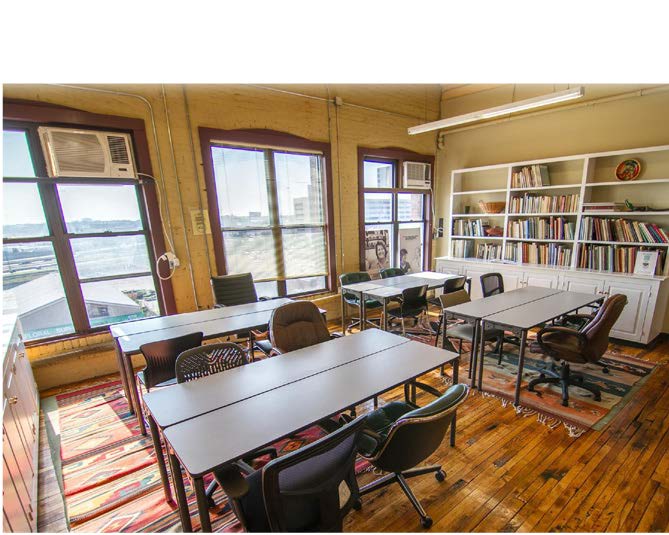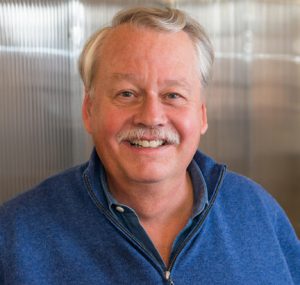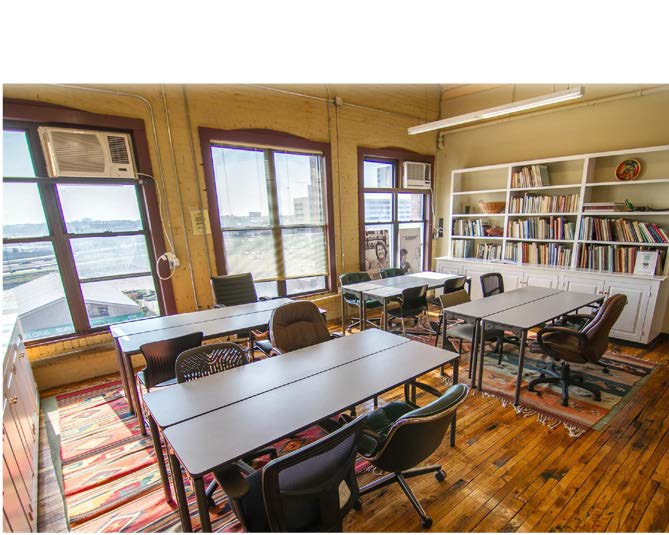
A Friend of Foodies, Bruce Shaw Knows the Trends, Bruce Shaw ’70

If you’re feeling virtuous, you may want to climb the four flights of stairs to reach The Food Loft in an old Boston building that has harbored many enterprises over the decades. But be warned, ceilings are high here. The elevator’s a treat, anyway: tucked beside the lobby, a dark door pulls open to reveal an iron, accordion gate. Choose your destination, close the gate and hum while your linoleum-floored cab ascends confidently. Inside The Food Loft, warm kilim rugs, comfortably chic furniture, burgeoning bookcases and a dazzling collection of wall art and sculpture surprise the first-time guest. It’s a lively place with plenty of comings and goings, and clusters of people in purposeful conversation.
Bruce Shaw ’70 and co-founder Adam Salamone fashioned this workspace for food start-ups from space where Bruce’s publishing house, Harvard Common Press, operated. In “a supportive community space that helps food businesses launch, grow and thrive,” as it’s self-described, Food Loft members can find mentors, strategic resources, office and meeting spaces, and early stage investment.
Bruce’s and Adam’s idea was to tweak the business incubator model to support entrepreneurs at the intersection of food and technology. Food start-ups need distinct services. The workspace Bruce created beckoned to people with business ideas just when food innovation in Boston was ramping up. In fact, a “Boston food map” on thefoodloft.com shows the virtual pileup of new companies, as well as other incubator sites where food production and distribution is the focus, rather than foodtech. The food-and-tech combo might include online recipe resources for particular groups, such as heart disease or cancer patients; food delivery services; restaurant reservations for different kinds of space needs; and point-of-sale efficiencies to improve the guest experience.
 In addition to providing spaces for conferences, right-sized, furnished offices, and a kitchen, The Food Loft hosts events, like workshops on digital marketing or receptions with BostInno, Boston’s innovation journal. Bruce notes the importance, also, of maintaining a willing advisory board as resources for their resident entrepreneurs. The operation is time-intensive: “I spend a lot of time talking to entrepreneurs, usually, about their businesses,” Bruce says.
In addition to providing spaces for conferences, right-sized, furnished offices, and a kitchen, The Food Loft hosts events, like workshops on digital marketing or receptions with BostInno, Boston’s innovation journal. Bruce notes the importance, also, of maintaining a willing advisory board as resources for their resident entrepreneurs. The operation is time-intensive: “I spend a lot of time talking to entrepreneurs, usually, about their businesses,” Bruce says.
He and Adam have something that innovators have found valuable, Bruce says. “We understand the food and marketing side of an idea that, in all likelihood, a creative techie (who may claim to be a foodie) has hatched, about how technology can better service the food world.”
The Food Loft positions Bruce midstream in the flow of food trends. Partnering with Adam, he’s an investor himself now, since investing in the website Yummly in 2009. Bruce’s migration to the venture capital world is a modern tale with ancient elements: sticking with what you love, and finding opportunity in challenge.
“To be clear, out of college, my passion was really books and reading,” says Bruce. “That’s what I did as a child. I was a reader. I was not athletic at all. I just love books. And that sort of runs in my family. My grandfather was a publisher and wrote some books.”
After graduating from Bowdoin, and a short stint at a bank, Bruce interned for Boston publisher David Godine, and ultimately earned street credentials and sales savvy peddling Godine’s publications to college libraries throughout New England. He then bought “a very, very, very small publishing company,” he explains, “and I make that point because it didn’t cost very much.” In 1984, he moved the Harvard Common Press into his current South End building, and 15 years ago relocated to the spacious fourth floor because “we were growing; we were hiring people and needed more space.”
“So up until 10 years ago we were publishing in three or four different areas: books on small business, travel guides and cookbooks. We ended up licensing a series of travel guides to Houghton Mifflin [Where to Stay in New England, and follow-up guides about various national and international sites], and I became the editorial director of the series, which was a very sort of fun and an interesting thing to do.”
As Houghton Mifflin published the travel series, Bruce’s press began to focus intensely on cookbooks. They’d had solid success with several of their cookbooks in particular, and the marketing of cookbooks was a distinct specialty among publishers.
 “It’s one of those things where it all came together. We had authors who absolutely knew what they were doing, and knew how to write, along with a great cookbook editor. And in publishing, you have to have that for a book to really be successful,” says Bruce. For example, Smoke and Spice, about barbecuing with smoke, was published by Harvard Common Press in 1994. It’s a book that sold well over one million copies, “and continues to sell well every year,” Bruce says.
“It’s one of those things where it all came together. We had authors who absolutely knew what they were doing, and knew how to write, along with a great cookbook editor. And in publishing, you have to have that for a book to really be successful,” says Bruce. For example, Smoke and Spice, about barbecuing with smoke, was published by Harvard Common Press in 1994. It’s a book that sold well over one million copies, “and continues to sell well every year,” Bruce says.
Cookbook publishers are necessarily very involved with food, Bruce explains, understanding trends in the food world — what and where people are eating, who’s coming along, chefs or writers, and who’s bringing out new ideas. “I did a tremendous amount of reading and learning, as everyone here did.” Bruce says, “Everyone who worked here was a real expert on the food world.”
When Adam joined the staff in 2008, Harvard Common Press was trying to figure out how to digitize and monetize all their content. As were all publishers, they were taking up the challenge of how their content could earn money, other than between two paper covers. “We figured it out,” Bruce says, so that everything is available on all devices.
Energized by new digital possibilities, Bruce got to work researching a concept for an ambitious travel website, the likes of which he may have wished he had when he was writing his travel guides. While he and Adam shopped around this travel site idea, they encountered investors interested in their background, and in the combination of food and tech.
Bruce was intrigued by founder Dave Feller’s concept for Yummly, a site designed to match people’s taste preferences with recipes curated for exactly those tastes. He and Adam invested in Yummly (which was eventually bought by Whirlpool). “It was kind of an extension of the idea of digitizing our content,” Bruce explains. “We created recipes, and what he was going to be dealing with was recipes, so that was the touch point.”
They came to realize the power of their expertise in food, food trends and the marketing of food. One of their early investments, for example, was in a food delivery company called Caviar, which was bought by Square. The fire had been lit, and Bruce and Adam started looking at other investments around food, where their experience and proficiency balanced out an entrepreneur’s idea about what might be possible through technology. “And that’s what we do, here.” Bruce says simply. “We invest in start-ups.” Both Bruce and Adam know much more about technology’s opportunities now, and they’ve only increased their knowledge of food, specialized marketing for food-related business, and aspects of the food world that are targets for innovation.
The publishing company’s business success fueled the new companies, which led to ultimately shrinking the Harvard Common Press and the transformation of the publishing floor into a thriving workspace for startups and a constantly fresh source of ideas. Bruce and Adam have offices in New York and San Francisco, as well as Boston.
“We’re very serious about this,” Bruce says. “I know the food world. I’ve been in it for my whole professional life, really, and particularly over the last 20 years when we started to crank up the cookbooks. I live and breathe it. So when someone comes in with an idea, and even though we may not yet understand how the technology behind it might work, it’s a food idea, so we can start seeing it and put some skin on it. I think that’s fascinating. I just really enjoy that.”
by Cathleen Everett




